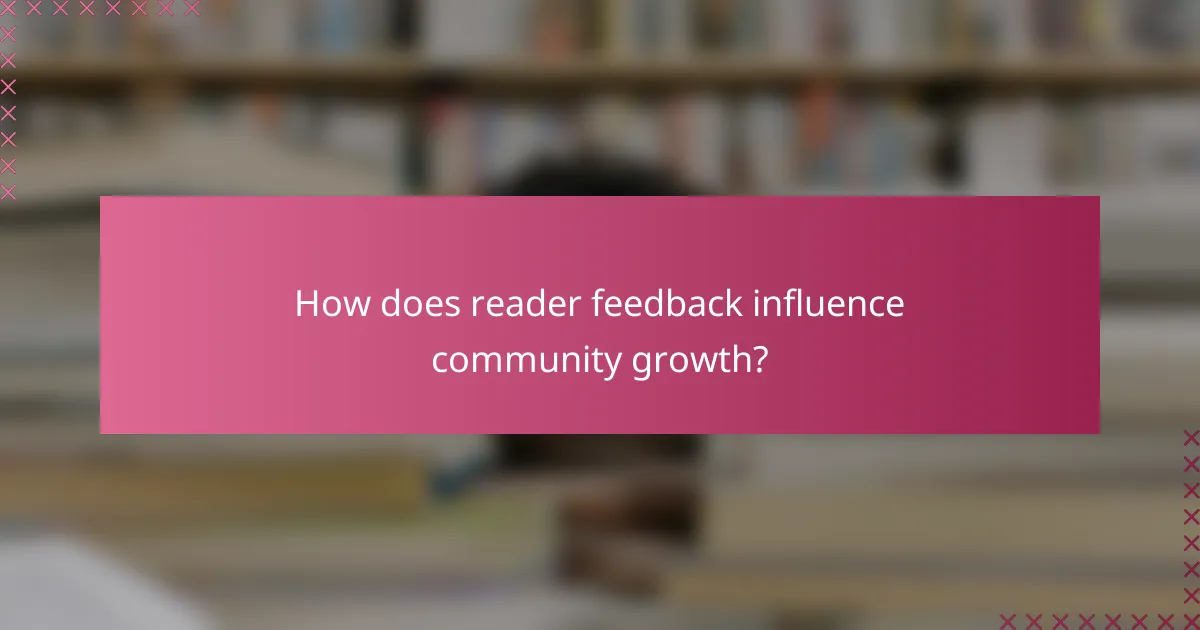Reader feedback is a vital component in shaping brand identity, offering valuable insights into customer perceptions and preferences. By actively engaging with their audience, brands can adapt their messaging and offerings, fostering a sense of community and encouraging ongoing interaction. This approach not only enhances brand loyalty but also drives community growth by creating a more inclusive environment for participation.

How can reader feedback shape brand identity?
Reader feedback is essential for shaping brand identity as it provides insights into customer perceptions and preferences. By actively listening to their audience, brands can adapt their messaging and offerings to better align with consumer expectations.
Enhances customer understanding
Gathering reader feedback allows brands to gain a deeper understanding of their customers’ needs and desires. This insight can reveal gaps in the market or highlight features that resonate well with the audience. For instance, surveys and social media polls can be effective tools to collect this information.
Brands should focus on asking specific questions that elicit detailed responses. Open-ended questions can often yield richer insights than simple yes/no queries. Regularly analyzing this feedback helps brands stay attuned to evolving customer preferences.
Informs product development
Reader feedback plays a crucial role in informing product development by providing direct input on what consumers want. Brands can use this information to refine existing products or develop new ones that meet market demands. For example, if customers express a desire for eco-friendly packaging, brands can prioritize sustainable materials in their product lines.
Incorporating feedback into the development process can reduce the risk of launching products that do not meet customer expectations. Brands should implement a feedback loop where consumer insights are continuously integrated into product iterations, ensuring alignment with customer needs.
Builds brand loyalty
Actively engaging with reader feedback fosters a sense of community and loyalty among customers. When consumers see that their opinions are valued and acted upon, they are more likely to develop a strong emotional connection with the brand. This can lead to repeat purchases and positive word-of-mouth referrals.
To build loyalty, brands should communicate how they have implemented feedback into their offerings. Sharing success stories or improvements based on customer suggestions can reinforce the message that the brand is committed to meeting their audience’s needs. Regular engagement through newsletters or social media can keep the conversation going and strengthen brand relationships.

What are effective strategies for engaging with reader feedback?
Effective strategies for engaging with reader feedback include actively seeking input through various channels, analyzing the responses, and implementing changes based on the insights gathered. This approach fosters a sense of community and encourages ongoing interaction between the brand and its audience.
Utilizing surveys and polls
Surveys and polls are powerful tools for gathering reader feedback. They can be distributed via email, social media, or directly on your website, allowing you to reach a broad audience. Aim for concise questions to increase response rates, and consider offering incentives like discounts or exclusive content to encourage participation.
When designing surveys, use a mix of multiple-choice questions and open-ended responses to capture both quantitative and qualitative data. Analyze the results to identify trends and areas for improvement, ensuring that you act on the feedback to demonstrate responsiveness.
Implementing feedback loops
Feedback loops involve continuously collecting and responding to reader input, creating a dynamic exchange. Start by establishing clear channels for feedback, such as comment sections, dedicated email addresses, or social media platforms. Regularly review this feedback and communicate any changes made as a result.
To maintain engagement, consider scheduling periodic updates to inform readers about how their feedback has influenced your content or services. This transparency builds trust and encourages more readers to share their thoughts in the future.
Creating community forums
Community forums provide a space for readers to share their opinions and engage with one another. Platforms like Reddit, Discord, or even a dedicated section on your website can facilitate discussions around your brand. Ensure that the forum is moderated to maintain a positive environment and encourage constructive dialogue.
Promote the forum through your existing channels to attract participants, and consider hosting regular events or Q&A sessions to stimulate conversation. By fostering a sense of belonging, you can enhance reader loyalty and gain valuable insights from ongoing discussions.

How does reader feedback influence community growth?
Reader feedback plays a crucial role in community growth by providing insights that shape content and engagement strategies. By actively listening to their audience, brands can create a more inclusive environment that encourages participation and loyalty.
Encourages user-generated content
Reader feedback often inspires users to contribute their own content, such as reviews, testimonials, or creative works. This user-generated content not only enriches the community but also adds authenticity to the brand’s offerings.
Brands can facilitate this by creating platforms or campaigns that invite users to share their experiences. For example, a social media challenge or a dedicated hashtag can motivate users to engage and showcase their creativity.
Strengthens community connections
Feedback fosters stronger connections among community members by encouraging dialogue and collaboration. When readers feel heard, they are more likely to interact with each other, forming bonds that enhance the overall community experience.
To leverage this, brands should create spaces for discussion, such as forums or comment sections, where feedback can be shared openly. Regularly acknowledging and responding to feedback can further solidify these connections.
Drives word-of-mouth marketing
Positive reader feedback can significantly boost word-of-mouth marketing, as satisfied community members are likely to share their experiences with others. This organic promotion is often more credible than traditional advertising.
Brands should encourage satisfied users to share their feedback on social media or through referral programs. Providing incentives, like discounts or exclusive content, can motivate users to spread the word about their positive experiences.

What tools can enhance reader feedback collection?
Several tools can significantly improve the collection of reader feedback, helping brands understand their audience better. Utilizing platforms designed for surveys, interactive feedback, and support insights can streamline the process and yield valuable data.
SurveyMonkey for surveys
SurveyMonkey is a popular tool for creating and distributing surveys to gather reader feedback. It offers customizable templates and a user-friendly interface, making it easy to design questions that target specific insights.
Consider using SurveyMonkey’s analytics features to track responses over time. This can help identify trends and areas for improvement. Aim for a response rate of 20-30% for effective data collection.
Typeform for interactive feedback
Typeform excels in creating engaging, interactive feedback forms that enhance user experience. Its visually appealing interface encourages readers to provide more thoughtful responses compared to traditional forms.
Utilize Typeform’s branching logic to tailor questions based on previous answers, which can lead to more relevant insights. Keep forms concise, ideally under 10 questions, to maintain reader interest and maximize completion rates.
Zendesk for support insights
Zendesk is a robust platform for managing customer support inquiries and gathering feedback through ticketing systems. It allows brands to analyze common issues and reader sentiments based on support interactions.
Integrate Zendesk with other feedback tools to create a comprehensive view of reader experiences. Regularly review support tickets to identify patterns and prioritize improvements. Aim to respond to inquiries within 24 hours to maintain engagement and satisfaction.

How can brands analyze reader feedback effectively?
Brands can analyze reader feedback effectively by utilizing various tools and techniques that help interpret sentiments, visualize data, and establish consistent reporting. This process enables brands to understand audience preferences and improve engagement strategies.
Sentiment analysis tools
Sentiment analysis tools help brands gauge the emotional tone behind reader feedback, allowing for a deeper understanding of audience perceptions. These tools can categorize feedback as positive, negative, or neutral, providing insights into overall brand sentiment.
Popular sentiment analysis tools include Lexalytics, MonkeyLearn, and Google Cloud Natural Language. Each tool offers different features, such as real-time analysis or integration with social media platforms, making it essential to choose one that aligns with specific brand needs.
Data visualization techniques
Data visualization techniques transform complex feedback data into easily digestible formats, such as charts and graphs. Visual representations can highlight trends, patterns, and outliers in reader feedback, making it easier for brands to identify key areas for improvement.
Common visualization tools include Tableau, Microsoft Power BI, and Google Data Studio. Using these tools, brands can create dashboards that track feedback over time, enabling quick comparisons and informed decision-making.
Regular reporting frameworks
Establishing regular reporting frameworks is crucial for brands to consistently monitor and analyze reader feedback. These frameworks should outline the frequency of reports, key metrics to track, and the stakeholders involved in the review process.
Brands can benefit from monthly or quarterly reports that summarize feedback trends, highlight significant changes, and recommend actionable steps. This structured approach ensures that feedback is not only collected but also acted upon, fostering continuous improvement in brand engagement.

What are the best practices for responding to reader feedback?
Effective responses to reader feedback are crucial for building brand loyalty and community engagement. Best practices include acknowledging feedback promptly, personalizing responses, and implementing suggested changes when feasible.
Timely acknowledgments
Responding to reader feedback in a timely manner shows that you value their input. Aim to acknowledge feedback within 24 to 48 hours, even if a full response will take longer. This can be as simple as a quick thank-you message or an acknowledgment that their feedback is being reviewed.
Consider setting up automated responses for initial acknowledgments to ensure no feedback goes unnoticed. This can help manage expectations and demonstrate that you are actively listening.
Personalized responses
Personalizing responses to reader feedback fosters a deeper connection. Use the reader’s name and reference specific points they made to show that you have genuinely engaged with their comments. This approach can significantly enhance the reader’s perception of your brand.
Avoid generic replies; instead, tailor your message to address the unique concerns or suggestions raised. This could involve thanking them for a specific idea or providing additional information related to their feedback.
Implementing suggested changes
When feasible, implementing changes based on reader feedback can greatly enhance community trust and engagement. Prioritize suggestions that align with your brand goals and can be realistically executed. Communicate any changes made as a result of feedback to show readers that their voices matter.
For example, if multiple readers suggest a new feature or improvement, consider running a poll to gauge interest before making a decision. This not only validates their input but also involves them in the process, strengthening community ties.
